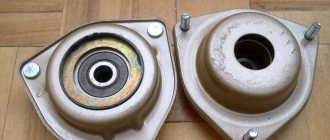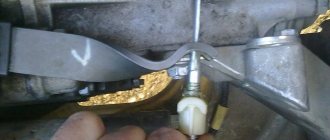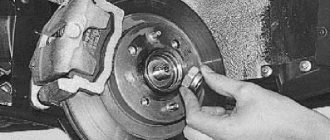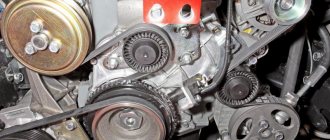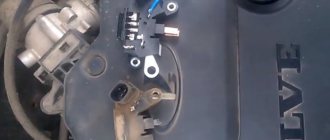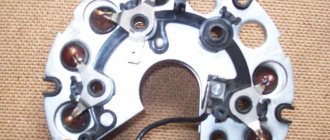The optimal lubricant for car generator bearings is provided by the manufacturer and is designed for the entire service life of the unit. In analogue spare parts, the lubricant is of poor quality, preservative or completely absent. Therefore, in the event of premature wear of a part due to malfunctions and the need to replace it, the question arises: “What kind of lubricant should I lubricate the bearings of a car generator so that they last a long time and do not make noise?”
Since the generator rotor rotates 2–3 times faster than the crankshaft and operates over a wide temperature range, increased demands are placed on lubrication. Read this article about when you need to change the lubricant in the bearings, how to choose it correctly, and what is the best lubricant for generator bearings available in Russia.
How to tell if your generator needs service or repair
Diagnosing problems with PG is quite simple. First of all, their occurrence is indicated by the appearance of extraneous sound from under the hood in the area of the generator - whistling and howling. If the noise intensity increases as the engine speed increases, there is no doubt that there is a problem with the bearings. One possible way to solve this is to lubricate the bearings. The best option is to replace them, especially since the kit is inexpensive (depending on the manufacturer, it will cost up to 3-4 hundred rubles).
But even new bearings can only be supplied with preservative grease. Check their condition and, if necessary, lubricate them to extend the trouble-free operation of the device. However, not every lubricant is suitable for use in such conditions. A car enthusiast needs to know how to lubricate a generator bearing.
LAST NEWS
Molykote Separator Spray Silicone Oil Improves Packaging Equipment Efficiency
The optimal solution for the production and maintenance of hydraulic hammers is EFELE MG-212 lithium grease
The design of the generator unit as a whole is quite complex - this mechanism consists of many elements, each of which performs a specific function. During operation, almost all component parts of the device are subject to wear; one of the elements that most often wears out is the generator bearing. You can learn more about the purpose and malfunctions of this part from this article.
Lubricants and their correct choice
Bearing lubrication is necessary for:
- reducing resistance (friction) when moving;
- partial heat removal and normalization of operating temperature conditions;
- softening mechanical shocks;
- protection against the development of oxidative processes;
- reducing mechanical wear of parts.
Various types of lubricants are used for rolling bearings - liquid and grease. Liquids are quickly produced and squeezed out of parts, and therefore require the organization of constant supply from the outside. For units where it is impossible to organize a constant supply (a car generator is one of these), grease is used in the bearings.
- base oil, which provides the actual lubrication of parts;
- a thickener that gives the lubricant a certain consistency;
- additives to obtain special properties.
To choose the right lubricant, you should take into account the properties of these materials, such as:
- viscosity – determines the possibility of forming an oil film, the thickness of which will ensure optimal operating conditions;
- channeling, which determines the behavior of the lubricant when parts move;
- drop point, reflecting the liquefaction of the lubricant under severe temperature conditions;
- the type of thickener on which most of the properties of the material depend;
- compatibility of additives with operating modes of parts.
Viscosity is the most important characteristic of lubricants. It is this that determines the thickness of the layer of lubricant formed for various shapes and materials of surfaces and bearing performance indicators - load, rotation speed, etc. Viscosity that is excessive for a given operating mode will cause the opposite effect - increased friction and overheating of parts. The optimal viscosity value is determined by the bearing rotation speed and operating temperature. Selection tables are provided in technical literature and on specialized Internet resources. The manufacturer of the bearing and generator must indicate the required value.
The thickener determines such basic properties of lubricants as channeling, water resistance, dropping point, etc. Experts consider thickeners based on lithium soaps to be optimal for PGs and their operating modes. Such auto lubricants are called lithium lubricants.
The dropping temperature must be significantly higher than the operating temperature of the part. This will protect the lubricant from separation (oil separation) and ensure optimal material behavior.
Types of additives are selected according to the specifics of the work. Their task is to protect surfaces from oxidation and mechanical damage (scuffing), increase the stickiness of oils, etc.
What kind of lubricant should I use to lubricate the generator bearings?
Operators and manufacturers recommend using lithium greases such as Litol-24M, Fiol-2 and its modifications (Fiol-2M, Fiol-2U), Tsiatim-201, Tsiatim-202, Tsiatim-221, LZ-31, LZ-62 and others with similar characteristics.
Litol-24M
Lithium grease allowing operation in the temperature range -40..+120 degrees. It reduces material consumption and provides effective protection against corrosion and wear.
Fiol-2, Fiol-2M, Fiol-2U.
Fiol-2 is a universal waterproof auto lubricant intended for rolling bearings operating under light loads. Fiol-2M has enhanced anti-corrosion, anti-wear and extreme pressure characteristics and operates at temperatures of -40…+120 degrees. Fiol-2U is an automotive lubricant for bearings of various types. Similar to Fiol-2M, but has better antioxidant properties and mechanical stability.
Ciatim-201, Ciatim-202, Ciatim-221.
Tsiatim-201 is a universal auto lubricant with a high level of all protective (against oxidation, corrosion, scuffing, etc.) properties, waterproof. Used at temperatures -60..+90 degrees. Tsiatim-202 has similar indicators, but with an expanded temperature range (-40..+120 degrees). Tsiatim-221 is intended for lubrication of bearings with rotation speeds up to 10,000 rpm. It is used in various industries, including military and space technology. Temperature range - -60...+150 degrees.
LZ-31, LZ-62.
Lubricants for sealed rolling bearings. They are introduced for the entire period of operation and do not require replacement. They have good antioxidant properties, anti-corrosion and anti-wear characteristics. They operate at temperatures of -40…+120 degrees.
The role of lubricants
The use of lubricants reduces friction on the surface of the roller-separator, dampens the impact load of the rolling elements on the cage and, accordingly, reduces noise during operation of the mechanism. Also, the use of lubricants promotes uniform distribution of heat from the friction surfaces, serves as a kind of buffer that protects the bearing from mechanical contamination (the higher the accuracy of the assembly and the higher the speed of its rotation, the more important this factor is), and also protects the metal surface from corrosion.
How to lubricate generator bearings
Many motorists are interested in the question: is it possible to lubricate a generator bearing? To do this you will have to remove it. The actions are performed in the following sequence:
- loosen the fastening nut and adjusting bolt on the generator;
- remove the alternator belt (if at this moment there is no noise when starting the engine, the problem is in the alternator);
- disconnect the wire from the negative terminal of the battery (to prevent short circuit during operation);
- remove the generator.
After this, you can begin disassembling the device:
- block the rotor (impeller) - a regular screwdriver is suitable for this;
- unscrew the nut and remove the pulley;
- remove the front cover by releasing the latches or unscrewing the nuts on the studs.
- remove the back cover;
- Remove the rotor from the front bearing.
As a result, access to the bearings pressed into the covers opens. They are removed (knocked out), lubricated or replaced with new ones. Assembly is carried out in reverse order.
Video instructions (very clear)
Self-diagnosis
A generator bearing is a device used to ensure that the shaft rotates with minimal resistance. This element receives and also transmits the load from the moving mechanism to other components of the structure.
Before changing the device, it is necessary to diagnose its performance; this procedure is quite simple:
- First you need to remove the strap from the pulley.
- Then the car engine starts.
- If there is no sound or hum after starting the engine, this indicates that the bearings of the device need to be changed.
Generator Bearing Grease
Current to power conversion calculator
Convert how many amperes a kW has online. Calculator for converting current amperes to power watts
The optimal lubricant for car generator bearings is provided by the manufacturer and is designed for the entire service life of the unit. In analogue spare parts, the lubricant is of poor quality, preservative or completely absent. Therefore, in the event of premature wear of a part due to malfunctions and the need to replace it, the question arises: “What kind of lubricant should I lubricate the bearings of a car generator so that they last a long time and do not make noise?”
Since the generator rotor rotates 2–3 times faster than the crankshaft and operates over a wide temperature range, increased demands are placed on lubrication. Read this article about when you need to change the lubricant in the bearings, how to choose it correctly, and what is the best lubricant for generator bearings available in Russia.
Density
This indicator is determined by the concentration of the thickener per volume of the base substance. Although, the density of the base oil also has a certain effect. Please note that you should not forget that density must be considered in conjunction with viscosity. The composition may have a high density, but the base viscosity will be low. Likewise, it can also have the opposite relationship. the NGLI scale is used to mark the density of lubricants
. On this scale, the minimum density is 0, the maximum is 6. All engineers believe that the level of density depends on the operating speed of the bearing. For car generators, it is recommended to use lubricants with a density of at least 5 points.
How to choose a good lubricant for generator bearings?
To determine which lubricant to use for car generator bearings, you need to study its properties and check its suitability for the conditions in which it will operate. Key characteristics are:
- Maintaining viscosity at different temperatures . Since the bearing operates in a wide temperature range - from -50°C during winter starting in cold regions and up to +120°C during rotor rotation, a good lubricant for car generator bearings should not harden when cooled and leak when heated.
- Additive content and type . The lubricant must contain preservatives (preserving its properties for a long time), anti-corrosion and extreme pressure additives.
- Resistance to washout . The lubricant must be resistant to water, which may enter the generator, and be minimally washed out by it.
- Drop point . This is a measure of the temperature at which the lubricant becomes liquid enough to start dripping. The higher the point, the higher temperatures the composition can withstand. For high-speed bearings, the dropping point is not lower than 150 degrees Celsius.
- Chemical resistance . During operation at high temperatures, the ingredients of the lubricant composition should not decompose and form oxides. These processes cause a rapid loss of lubricating and protective properties, so the lubricant for car generator bearings must be chemically stable.
Specialized bearing lubricant
Universal lubricants rarely satisfy all of the above requirements at once. A specialized lubricant designed specifically for use in medium- and high-speed bearings shows the best results. Therefore, when choosing what to pack a generator bearing with, you should look towards narrow-profile lithium-based products with a polyurea thickener with a viscosity class of NLGI-2.
An incorrectly selected lubricant will quickly lose its properties and lead to premature bearing failure. Increased belt wear and excessive fuel consumption cannot be ruled out. Therefore, it is better to immediately determine exactly what kind of lubricant is needed for the car’s generator bearings and apply it, rather than disassemble and service it every 5–10 thousand kilometers.
If the generator is already howling or crunching even when it’s hot, the bearing will soon have to be changed in any case due to high wear. If a new part is in doubt, it is better to remove the factory lubricant and replace it immediately.
Having determined which lubricant is best to lubricate the generator bearings and having prepared it, you need to thoroughly remove the remnants of the old lubricant. Lubricants with different compositions can undergo undesirable chemical reactions, which often lead to the loss of their key properties and rapid wear of balls and rings.
Possible faults
By what symptoms can you understand that it is time to change the bearings on the generator:
- The device buzzed. If the generator unit makes noise after starting the engine, then most likely the reason is inoperative bearing devices. It happens that devices hum, and then stop. There is no need to think that the problem has resolved itself; the parts will still need to be replaced.
- The battery is charging unstably, this is due to problems in the operation of the shaft, in particular, its rotation. This problem can be indicated by a control indicator on the car’s dashboard.
- The assembly pulley rotates.
- Bearings should also be replaced if the devices become overheated. Overheating is caused by high friction of worn-out components (the author of the video is the altevaa TV channel).
Briefly about the reasons why these parts may fail:
- Components have worn out, in particular the rolling element, cage, sealing component or raceway. Many car owners think that if they lubricate the bearing in such a situation, this will solve the problem, but this is not true. Wear cannot be eliminated, so parts will have to be replaced.
- All bearing elements are initially lubricated during installation. Every car owner who has installed and lubricated parts knows how important lubrication of generator bearings is for the performance of the unit. If for some reason the lubricant is out or its level is insufficient, this can lead to accelerated wear of the part.
- The reason may also be the rotation of the outer race in the device body on the rotor shaft. This reason is also due to wear and tear of the elements or their defects.
- Abrasive particles could get inside the structure of the part, this will lead to not only noise, but also squeaking.
- Belt failure, use of an incorrect or defective belt on the shaft.
- Pulley imbalance. In case of such a malfunction, you must first find out for what reasons the imbalance occurred, and then solve this problem.
- Rotating the pulley (video author - Geha Lavbinovich).
Rating of the best lubricant for generator bearings
Special lubricants used for generator bearings cost a little more, but are rarely required and last a long time. Trying to save money by purchasing or using a universal lubricant with a viscosity grade of NLGI-2 can backfire. Mixtures that are not suitable for high loads work worse and are quickly washed out and worn out. Good lubrication for car generator bearings will avoid regular maintenance of this unit. Our rating of popular lubricants will help you choose it.
| Lubricant brand | Characteristic Feature | Price for 2022 |
| Ciatim-221 | Inexpensive Russian calcium silicone grease for bearings rotating at speeds up to 10,000 rpm. | from 700 rubles/can 0.8 kg |
| Molykote BG-20 | Professional polyester lithium bearing grease with very low resistance and washout. | From 12,000 rubles, 1 kg jar |
| Total Altis SH2 | French polyurea grease for high-speed components, including bearings of electrical machines. | From 1000 rubles/tube 400 grams |
| SKF LGHP 2 | Specialized bearing lubricant from the largest manufacturer. Recommended for high-speed electrical machines (motors and generators). | From 1000 rubles/tube 400 grams |
| MC 1510 2 BLUE | Russian (VMP Auto) high-temperature blue grease for bearings and other mechanisms, an improved analogue of the classic 158. | From 100 rubles/pack of 50 grams. From 500 rubles/tube 400 grams |
| CASTROL LMX | Universal British green lithium grease for generator bearings, high-temperature (drip drop of at least 260 degrees Celsius), with a complex of additives to protect components and stabilize the properties of the lubricant composition. | From 700 rubles/tube 400 grams |
| Chevron (Texaco) Delo Grease EP | Universal American extreme pressure grease based on mineral oil and lithium thickener. Protects against corrosion and scuffing. | From 400 rubles/tube 400 grams |
| Shell Alvania EP2 (aka Shell Gadus S2 V220 2) | British grease based on mineral oil and lithium thickener. Suitable for generator bearings, good resistance to washout | From 300 rubles/tube 400 grams |
| Mobil Polyrex EM | American polyurea grease, which can withstand high speeds and temperatures, is poorly washed out, but does not like severe frosts. | From 800 rubles/tube 400 grams |
What not to lubricate car generator bearings
In addition to the best lubricants for generator bearings, we list undesirable lubricant options that are often mistakenly recommended and used for the same purposes:
- Litol 24 is a universal automotive lubricant that is also suitable for bearing units, but loses its properties outside the temperature range of -30 – +120 °C.
- Mobil XHP 222 is a popular and high-quality, but too viscous lubricant that is poorly suited for high-speed bearings, despite frequent recommendations for this purpose.
- Grease No. 158 is the famous blue grease for generator bearings, which was popular in Soviet times, as it was superior to grease and other publicly available grease. Its properties are inferior to modern compounds, so its use is not recommended.
- LZ-31 and LZ-62 are Soviet lubricants, which were similarly good in their time, but are now inferior to specialized lubricants.
- Fiol-2 is similar to Litol-24, but more fluid and designed for parts operating in less aggressive conditions. Therefore, lubricating generator bearings with Fiol is a bad decision.
Remember that under normal operating conditions (city and highway driving) sealed bearings do not require maintenance. They can last until the generator wears out completely. But if the bearings are open or the machine operates in difficult conditions (dirt, off-road), then even good lubricant is washed out and degrades faster . In this case, you need to periodically service the generator bearings or change them if, after lubrication, they soon begin to make noise again.
If lubrication no longer helps, after a short time the generator makes noise again - change the bearings by selecting a part of the required size from a trusted manufacturer, for example, SKF or NSK. In addition to the size of the bearing, its clearances are important. For high-speed units subject to overheating, class CN (normal) or C3 (increased) is needed, since when heated the balls expand and the clearance decreases.
If, for example, you install a bearing with insufficient clearance in a generator, it will quickly become unusable due to increased friction forces when the balls expand.
Stories of car enthusiasts.
Pavel, Lada VAZ 2114:
“I came across this. I installed new NTN bearings on the generator. They are closed, but at the service center they advised to open and check - often even new ones turn out to be “dry”. With the front one, when I took off the protection, this turned out to be the case. I filled it with Tsiatim-221, about 50%. I closed it and installed it. No problems so far."
Sergey, Nissan Vanette:
“I want to share my experience on how to lubricate a generator bearing without removing it. I have serviced it this way several times, everything works silently. The protection on them is metal-rubber, like an oil seal. I pry it off with an awl or a thin knife, carefully so as not to damage the rubber seal. The cover can be removed without deformation. I score with Fiol-2M, at 1/3-1/2. There is a groove in the bearing race for protection; the oil seal is installed in place without much effort or problems, until a characteristic click is heard.”
Oleg, Toyota Camry:
“I would like to answer everyone who advises lubricating generator bearings. Read the manuals for the car. It says maintenance-free and does not require lubrication, since it is already packed at the factory, and the bearing itself is protected. A good friend works in a service center and says that branded components never require additional maintenance (they took it apart and checked it several times). And for those who want to lubricate it further, you will only cause harm, and the friction will increase, and it will heat up more (up to the formation of a monolith), and the protection can be pushed through, and lubricant can be squeezed onto the contact rings. Then there will definitely be extra problems with charging, etc. Just don’t save money by buying a Chinese counterfeit, take branded ones, the difference in price is 200 rubles.”



